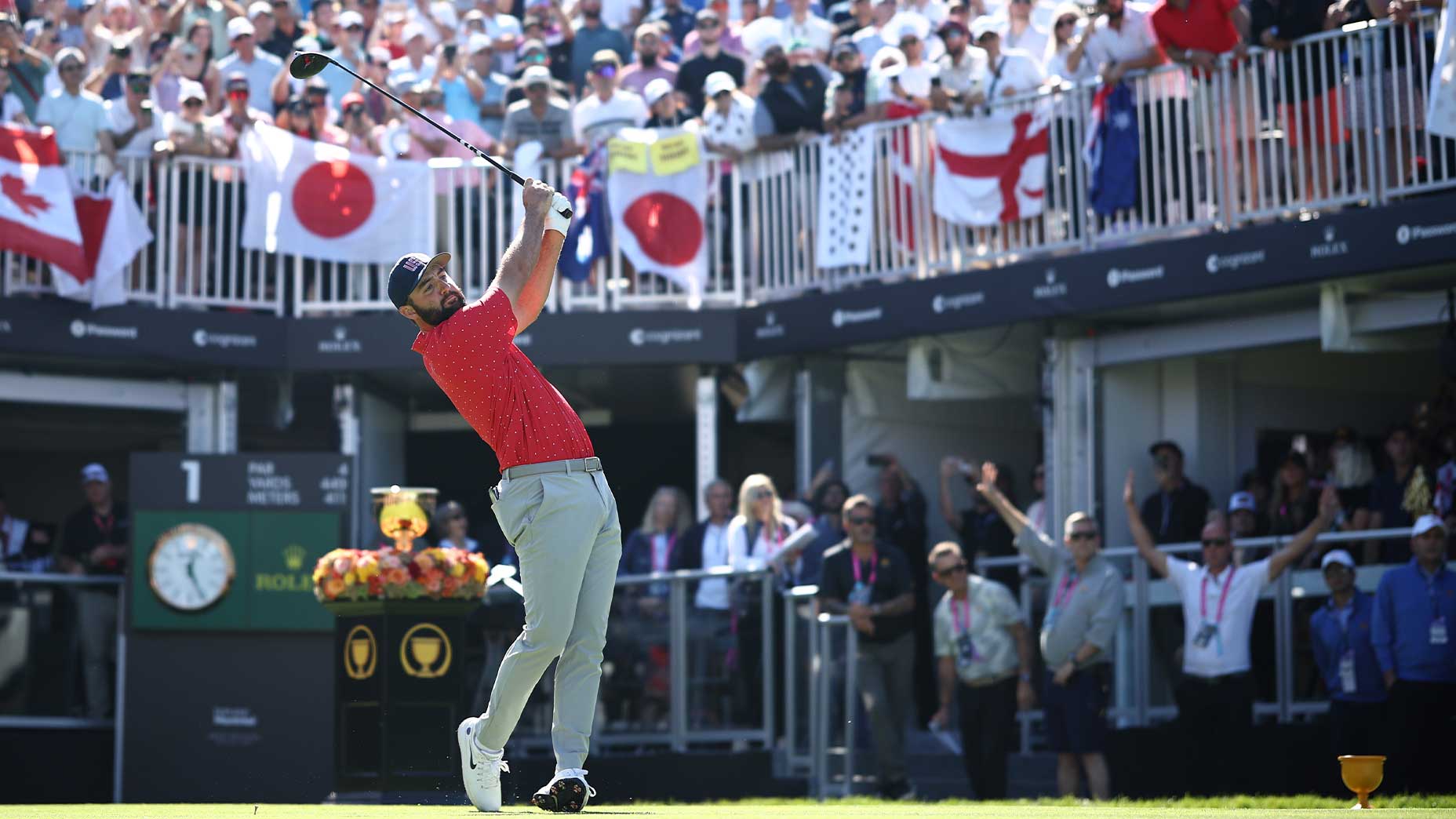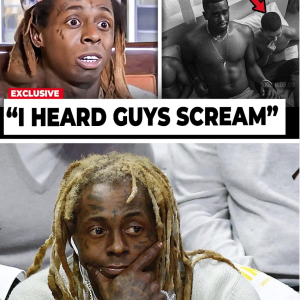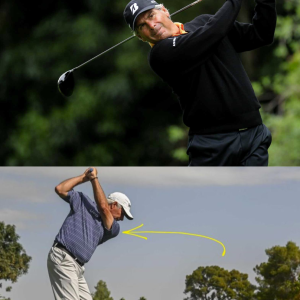The road to hell is paved with good intentions … and sports leagues that went head-to-head with the NFL.
That is a lesson the PGA Tour has learned painfully over the last three decades of Presidents Cups, and learned again last Sunday in Montreal, when the final day of one of the best tournaments of the 2024 golf season drew an audience of 1.4 million average viewers on NBC, well below typical PGA Tour weekend numbers.
The reason for the Presidents Cup’s lower-than-usual numbers should come as no surprise to sports fans with working televisions: the vast majority of Sunday’s singles matches overlapped with week 4 of the NFL season, which attracted the attention of the lion’s share of the sports-watching audience across the United States on Sunday afternoon. But the numbers also paint an interesting question for the Tour and its broadcast partners concerning future Presidents Cup telecasts: Why?
Typically, golf TV windows are built out of necessity; an event can only air during daylight hours, and it takes time for the entirety of the field to play a full, 18-hole round. As such, the late-afternoon Saturday and Sunday windows make sense as golf’s typical broadcast schedule because they overlap at the intersection of when an event can conclude and when a network is likely to have the attention of the full country watching.

But Sunday’s singles matches at the Presidents Cup faced no such necessities. With only 24 players competing and matches ending as soon as one side was mathematically eliminated, the PGA Tour and its network partners faced an unusually brief competitive window. In theory, that meant the telecast could air during any daylight window on Sunday, so long as both parties (the Tour and the network) agreed.
That thinking is why several viewers were surprised when Sunday’s singles matches at the Presidents Cup — the final day of a thrilling competition for both sides — aired starting at noon ET, ensuring almost an entire day’s worth of overlap with the NFL. Weren’t both sides be in agreement that better ratings would come without the NFL as competition? And wouldn’t ratings be better if the tournament aired then?
All of it brings us back to our central question — why? — and an answer that isn’t nearly as obvious as it seems.
***
The truth is that football is an unavoidable obstacle for the Presidents Cup in 2024.
The Cup’s current points system — and the PGA Tour’s sweeping yearlong calendar — necessitates the event landing in the middle of the fall schedule, a few weeks after the end of the PGA Tour season and the beginning of the NFL’s. As such, every iteration of the event since its formation three decades ago has competed in some way with the NFL and college football calendars and the monolithic television audiences the two sports attract.
The resilience of NFL TV ratings means the league has achieved a sort of black-hole status on television. Football is the last regular TV product capable of hoovering up reliably big audiences, and as audiences get smaller, the NFL attracts an even bigger piece of the ratings share. (The first four weeks of 2024 have netted the NFL its best ratings in nine years despite falling viewership trends across the rest of television.) This phenomenon is important for NFL “competitors” like the PGA Tour because it reinforces the obvious: competing with the NFL is a bad idea.
But sharing the NFL’s competitive days doesn’t have to mean sharing the same competitive hours. Especially for the Presidents Cup, with its smaller television window. So why has the Cup’s final day so often aired directly opposite the NFL despite owning a TV window that is short enough to fill the morning hours before a 1 p.m. kickoff? The answers are many.
First, there’s no guarantee a schedule change would improve viewership. In theory, more people would be inclined to tune in at 7:45 a.m. ET than in the middle of the NFL’s “witching hour” — and in theory, airing without competition is better than airing in conflict with the NFL. But without doing it, it’s impossible to say how audiences would respond, especially with an earlier schedule likely missing some of the U.S. West Coast audience.
Second, changing the TV schedule might not even avoid the NFL. When possible, the Tour and NBC have worked together to avoid conflicting with the NFL, but truth be told, even those efforts haven’t always gone according to plan. A 90-minute fog delay forced NBC to extend its Presidents Cup broadcast window on Saturday evening, leaving the Cup’s most dramatic moments to air opposite the heavily anticipated Georgia-Alabama football game. Despite both sides’ best efforts, the golf still aired opposite a massive football game.
Third, it would be an awkward ask. Football isn’t the only enemy facing shapeshifting PGA Tour broadcast windows. The Tour has spent years building viewership habits that fall during certain hours of the day, and has made lots of money from the coveted, late-afternoon weekend viewership slot they own during the nine months of the year the NFL isn’t competing. There’s also the human element of making a shift: it would be an inconvenience, at best, to ask a (very lucrative) partner in NBC to flip the Presidents Cup’s broadcast window, and the supposed audience benefits of such a move are far from guaranteed to either party.
News
The 2024 Presidents Cup ended with a lopsided score but no lack of drama.
In its most dramatic moments, this Presidents Cup delivered something special
By: Dylan Dethier
Fourth, and perhaps most importantly, NBC might not be interested in a change. The TV-change argument assumes that NBC and the PGA Tour are equally committed to maximizing Presidents Cup TV viewership, but the reality is that they might not be. (This isn’t to say that NBC doesn’t care about the PGA Tour — that’s an entirely different story — just that in this instance, NBC might rightfully have other concerns.) The truth is even the biggest PGA Tour TV partners have six days and 12 hours worth of non-golf programming in their schedules each week. Switching a Tour telecast isn’t as easy as flipping out a noon start time for an 8 a.m. one; it involves coordination with other shows, broadcast rules., contracts and audiences. (For all people speak about the NFL’s schedule flexibility, its schedule is remarkably rigid: kickoff deviates from its typical start times only on exceedingly rare occasions.)
And fifth, changing the Sunday singles schedule raises a bigger question about what the Presidents Cup actually is. Football or not, the Tour and its television partners have faced problems with the Cup’s TV schedule for as long as it has existed. While golf diehards, the PGA Tour and most of the golf establishment can agree that international iterations of the Presidents Cup are important for the growth of golf globally, television partners have seen viewership crater during overnight, tape-delayed affairs in the U.S. These sports league/network relationships are ultimately a give-and-take, which necessitates making hard decisions about what is ultimately worth an investment.
Of course, all of these reasons bring very valid counterarguments. Like how saying “we’ve always done this” is rarely a good rationale to continue doing something. Or how we don’t know that ratings would be better in the morning, but we can be pretty sure they wouldn’t be considerably worse. Or how a new schedule might not avoid the NFL entirely, but a few extra hours on TV wouldn’t hurt. Or how if Presidents Cup is important to the global future of golf, it might be worth the inconvenience and the risk, anyway.
In either case, you can be sure that voices on both sides of the Presidents Cup ledger — that is, the Tour and the network — are thinking about these things as the golf world shifts away from Montreal.
After all, you weren’t the only one paying attention to the NFL scoreboard as the Presidents Cup waned on Sunday.





